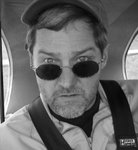a story by Paul Berge, © 1989
A dead airport often takes a long time to decay. The lucky ones, when murdered by city councils, are quickly rendered. Their hangars are torn down, the debris trucked to dump sites. The airplanes scattered like flies from a shaken tablecloth. Then the bulldozers, the morticians at the controls, rip apart any trace of runway, ramps or foundations. When done correctly, five decades of aviation memory can be obliterated inside of a month. It's the only merciful way.
A dead airport often takes a long time to decay. The lucky ones, when murdered by city councils, are quickly rendered. Their hangars are torn down, the debris trucked to dump sites. The airplanes scattered like flies from a shaken tablecloth. Then the bulldozers, the morticians at the controls, rip apart any trace of runway, ramps or foundations. When done correctly, five decades of aviation memory can be obliterated inside of a month. It's the only merciful way.
The worst cases are the dead ones left unclaimed. They appear on sectionals as airport symbols with Xs in their eyes. They may be dead, but no one wants the body. Northeast of Des Moines, Iowa is one.
Jones Field. That was the last name it had, before someone, apparently named Jones, discovered how fruitless it was to compete with grass and smiles against the corporate muscle of kerosene and pavement. Now an airfield, once called Jones, lies dead.
It died in stages. First the airplanes left--not all. A Navion stayed, and a Cessna 175 and a Beechcraft Musketeer with flat tires and a glazed windshield. They looked like three old veterans, escapees from the VA home. Old fliers with more memories under the chipped paint and cracked vinyl than all the turbine screamers across town.
No longer able to fly, they became homes for sparrows and mice. Their humiliation continued as the vandals came and smashed out their instruments and left beer bottles on their seats. Someone put a bullet through the Navion's tail. There was no need, but it was done.
The runways went to seed. A farmer, working the neighboring field ran his disk across them, making them unusable, except to those who flew Champs and Cubs with big tires and tended to ignore NOTAMS and other death warrants.
I stayed with the airport through its final agonies. I saw the hangar lose its windows, then its UNICOM antenna and the CESSNA FLIGHT CENTER sign. I saw the picnic table where we once sat in the shade, watching Bill Norlin's Taylorcraft spot land on a bare dirt patch. And I saw the shop become an empty cavern of broken glass and stagnant puddles.
A tornado tried to put the coup de grace on the field but only smashed the T-hangars where the Navion and Cessna 175 remained. One was flipped onto the other, and they were both loaded onto flatbeds and hauled to the junk man. I never saw the Musketeer leave. I assume it, too, was hauled, not flown, away.
The runways are still discernible from the air, although I doubt the Lear drivers, heading for International, ever look. The lone hangar refuses to crumble, and I see more of its parts scattered around as though vultures were feasting on the carcass.
Jones Field--Des Moines, Iowa--is not dead yet, but hasn't much dying left to do.
***
© 1989, 2007, Paul Berge, all rights reserved.
